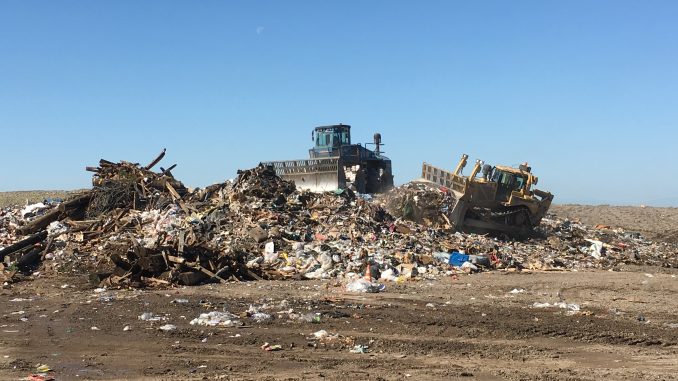
Butte County’s longest-running construction site changes daily, as it has for more than half a century. Neal Road Recycling and Waste Facility is in a constant state of transformation.
“Landfill customers are amazed,” says Eric Miller, Manager of the Waste Management Division for Butte County Public Works. “If they hadn’t been here for a few months, they see that the internal roads have all moved.”
To make room for more waste, the landfill’s 24-person crew keeps reshaping the contours of the site. Earth-movers push and compact the waste to make space for more material heaped on top. The facility’s highest elevation is about 480 feet above sea level–more than three times the height of Whitney Hall at California State University, Chico.
“Our fill sequencing is very strategic,” says Miller. “We’re always changing roads as we fill up each module. We plan our moves six months in advance. … It’s all carefully engineered.”
And in the landfill business, little goes to waste, he adds. “In our drop-off recycling area, we recycle mattresses, electronic waste, tires, scrap metal, carpet, cardboard and mixed beverage containers. At the disposal area, we scrape and reuse as much gravel as possible to conserve resources. We’re continuously road building.”
More than 7.2 million tons of waste have been buried at Neal Road landfill since it opened in 1970, the final resting place for consumer goods that are either unwanted or have reached their product life. About 200,000 tons more arrives each year. The challenge: Where to put it?
“It amazes me how quickly this place is filling. Butte County’s population has decreased since 2010, but our per capita waste disposal is up.”
Eric Miller
Manager, Waste Management Division, Butte County Public Works
“How do we best develop this site?” Miller says. “It’s a long-term challenge for us and other landfills, to maximize site life, while maintaining environmental compliance.”
The Neal Road facility is permitted for 140 acres of solid waste and is regulated by state air, water and waste agencies. Recent changes in environmental laws related to waste diversion, for example, SB1383 mandates cities and counties throughout California divert organic waste from landfill disposal. Organic waste (such as food scraps and yard waste) make up 34% of all solid waste. By converting such waste into biofuel or compost, it can in turn add many years to a landfill’s site life. Another major driving force of SB1383 is that diverting organic materials can help reduce greenhouse gas emissions.
To conserve precious air space, landfill material is compacted as much as possible, explains Craig Cissell, Deputy Director of Butte County’s Waste and Recycling Division.
With their drivers sitting 12 feet above the trash, giant blue compactors roll back and forth over layers of freshly delivered material. Humongous spiked wheels act like a blender and break up the trash while also crushing it, resulting in maximum compaction. So does their weight: 84,000 pounds.
A 40-ton bulldozer pushes waste into place. The site buzzes with the roar of their engines 10 hours a day, 360 days a year.
These machines aren’t cheap; they cost nearly $1 million each.
“We use 6,000 gallons of diesel a month,” Miller adds. “It’s been a challenge with the recent price of fuel.”
Waste material is sandwiched with protection. Multiple layers of state-of-the-art plastic liners blanket the bottom of each module to prevent leakage. “It has to last forever,” Miller says. Every night, crews cover the waste with either plastic tarps, soil or wood chips.
“We don’t want birds or other vectors to scavenge,” explains Cissell. “And we don’t want rain water to come directly in contact with waste.”
The next morning, the construction project picks up where it left off–trying to recycle as much as possible while squeezing in more trash.
“It amazes me how quickly this place is filling,” Miller says. “Butte County’s population has decreased since 2010, but our per capita waste disposal is up.”
Learn more at https://www.buttecounty.net/publicworks.

